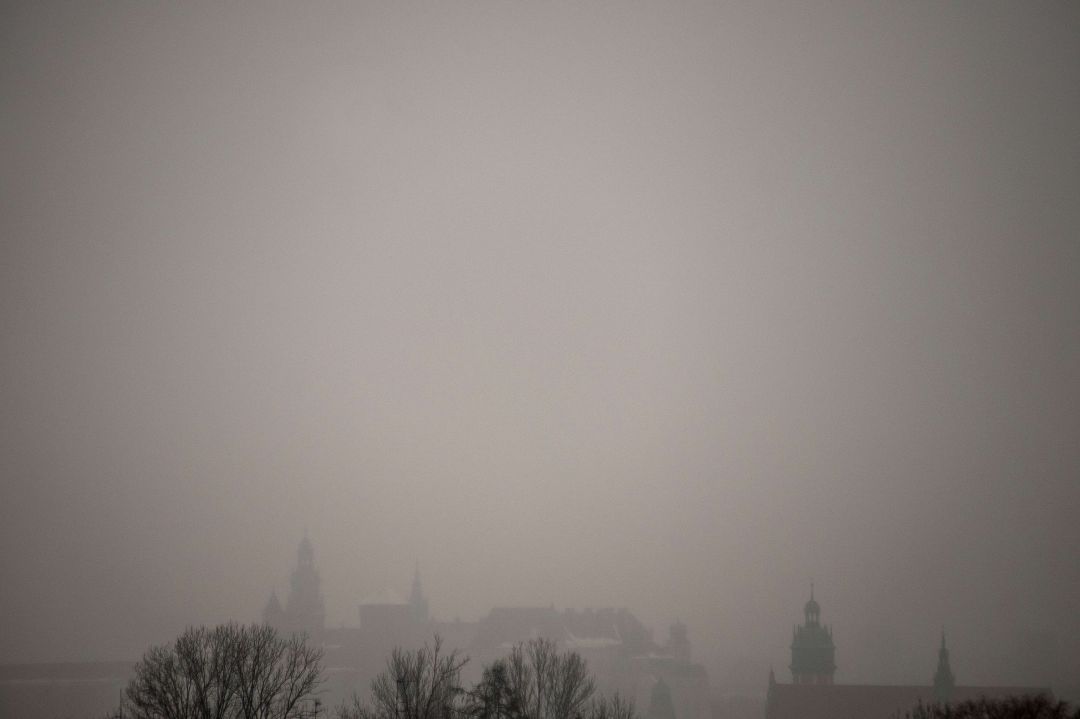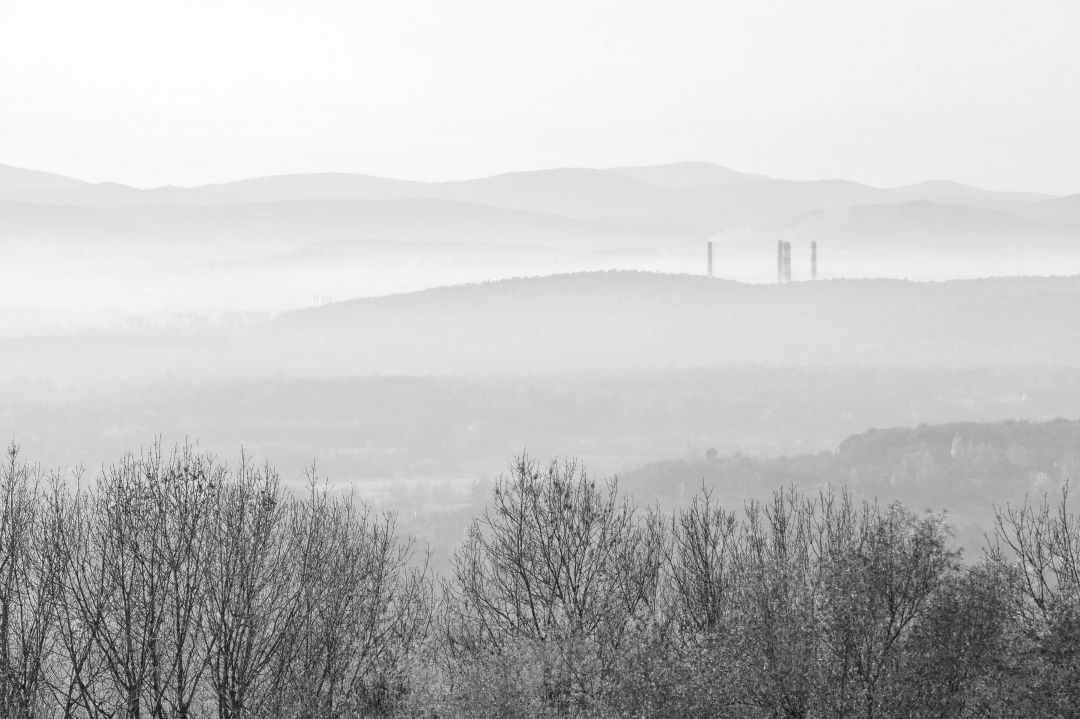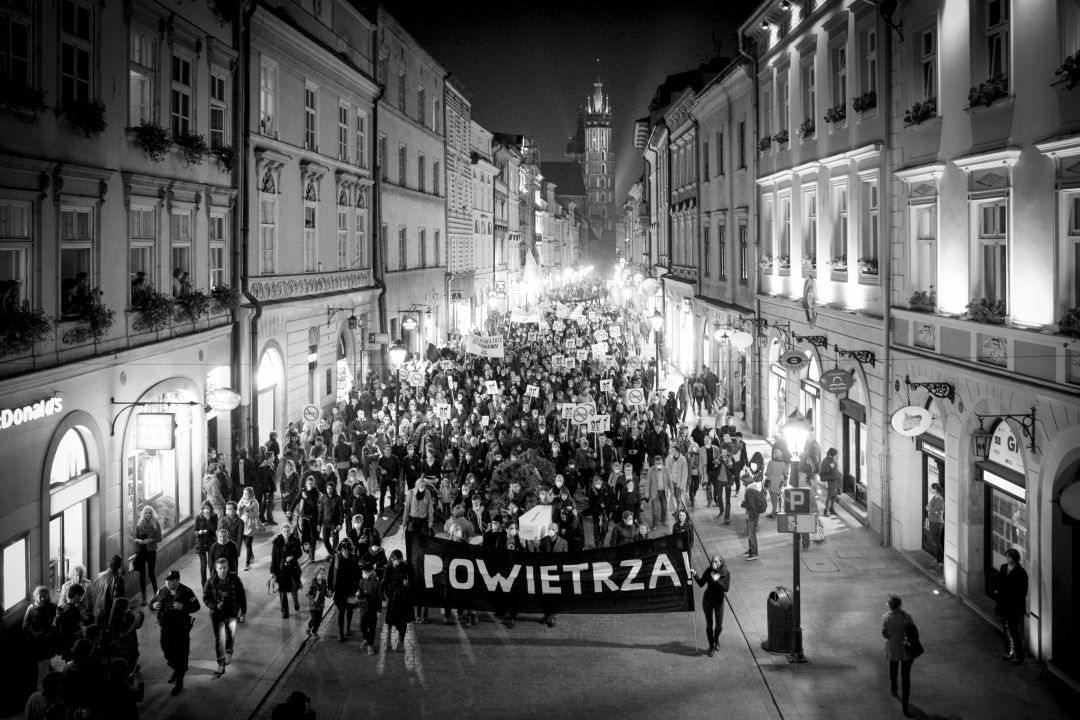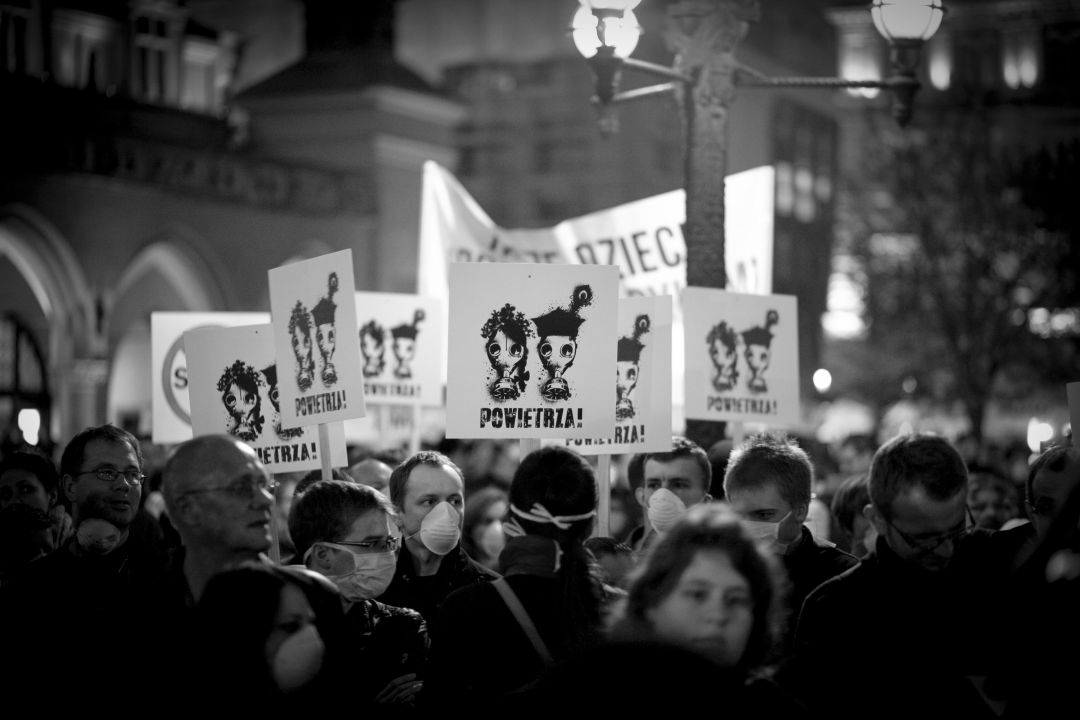Letting in fresh air for Europe’s smog champion
How Poland is freeing itself from air pollution.
Kraków had some of the most polluted air in Europe for a long time. Until its citizens had had enough. And the “Kraków Smog Alarm” brought fresh air into Poland’s environmental policy.
For a long time, Magdalena Kozłowska thought it was totally normal for winters in Kraków to be greyer than in other places. Even when the weather was good, a dark fog hung over its streets. On the edge of town, the smoke that billowed from the chimneys of the single family homes pressed down on passers-by, irritating their lungs, and left a layer of grey on the walls, the street lights, and garden fences. “When I got home, my clothing and my hair always smelled of smoke,” Kozłowska says.
Poland’s smog problem has been irritating many people for years. According to 2018 data from the World Health Organisation (WHO), of the 50 cities with the worst smog in the EU, 36 were located in Poland. Particularly in winter, when many households fill their old heating systems with coal and wood, the level of particulates in most regions regularly exceeds the limits set by the EU by a wide margin. In fact, Poland’s households are responsible for almost half of the country’s particulate pollution. Kraków was one of the worst offenders for a long time. Some years, the city exceeded the limits for air pollution on more than 200 days a year.
Magdalena Kozłowska remembers one winter eight years ago well. It was only November, and Kraków had already exceeded the pollution limits on every day of the month except one. That was the year that she and her environmental activist friends had had enough of the situation. They founded Krakówski Alarm Smogowy – the Kraków Smog Alarm (KSA). Kozłowska, who had been involved as an activist with various NGOs before that time, has been part of the KSA from the beginning.
Policymakers ignored the problem for a long time
The initiative’s first and most important task was to make it clear to the people of Kraków that smog exists, and that it’s a problem. Because, at the time, only a few people in the city understood just how serious the situation was. How could they – considering that the local media hardly ever talked about it, current air pollution data were hard to come by, and policymakers ignored the problem. “People could smell the smoke, but they didn’t understand that it was bad for their health,” says Kozłowska. “They just said, ‘That’s what it smells like in the winter’.”
“They just said, ‘That’s what it smells like in the winter’.”
Once people can smell and see the tiny air pollutants that smog is made up of, it’s already reached a concentration that is extremely hazardous to their health. When the air quality deteriorates, the immediate effects can include coughing, irritated eyes, trouble breathing, and chest pain. But the long-term effects on health are even worse.
The risk of developing asthma rises, as does the risk of suffering a heart attack, vascular disease, organ damage, and cancer. Smog is responsible for 4.2 million early deaths each year, according to World Health Organisation estimates. Air pollution caused the deaths of around 44,500 Poles in 2018, according to the European Environment Agency. A disproportionate number of them came from mountainous Southern Poland, where a mix of precipitation and topography sometimes enables smog to surround villages in mountain valleys for weeks. Older people, people with pre-existing conditions, and children all feel the effects more quickly than other people when they have to breathe in polluted air.

This picture was taken in February 2013. The thick, grey layer of smog blanketing Poland’s southern city of Kraków is one of the most visible symptoms of the EU member’s addiction to coal. Photo: © Bartosz Siedlik / AFP / picturedesk.com
Researchers from New York’s Columbia University and Kraków’s Jagiellonian University have discovered that even the unborn suffer from the effects of smog. The team of academics studied expectant mothers and school children in Kraków. They found that newborns in Kraków were smaller and weighed less than babies born in parts of Poland with very low levels of smog. There were cognitive effects too, with school children from Kraków having slightly weaker performance on intelligence tests.
However, these numbers did not make any impression on politicians in Kraków’s city parliament. There were models that offered various ways of reducing smog, and most politicians knew about the problem. But instead of calling it a problem, they thought it was normal. “They said, ‘That’s not important. We have bigger problems’,” Kozłowska recalls.
Coal for independence?
Very few Poles were happy when these activists decided to take aim at coal. Poland has its own coal reserves. This has made coal a symbol of energy independence and political independence for many politicians – in spite of the fact that Poland imports millions of additional tonnes of the commodity from countries like Russia, Australia, and Colombia each year in order to meet industrial and consumer demand for low-cost energy.

View from the Kościuszko hill in Kraków in October 2013. Photo: (CC-BY-SA-3.0) Anna Książek / Adam Rżysko / Wikimedia Commons
Poland’s government announced plans to stop importing coal from enterprises owned by the Russian state in early 2020. It will, however, continue to allow coal imports from privately owned enterprises. The activism of Magdalena Kozłowska’s initiative caused a stir in Kraków’s city parliament for another reason as well. “Politicians accused us of discouraging tourists from coming to Kraków,” says Kozłowska.
But these activists believe that there is more at stake here than their city’s reputation. So they decided to grow louder, more visible, and generate more support so policymakers can no longer ignore their ideas. They started with a Facebook page that tells people about air pollution, including the current air quality in their area, locations where air pollution is dangerously high, and the impacts that air pollution has on people’s health. This was followed by public meetings, advertising campaigns and petitions, and ultimately protests.
Local media coverage of the initiative increased with each step, as did the number of supporters. Only five people were on the campaign’s core team at the beginning, but more than 2,000 people attended the first round of protests in 2013. A petition for the city to ban solid fuels received more than 17,500 signatures in the same year. Soon there were apps that sounded the alarm when smog levels got too high, air quality reports on the radio and in the newspaper, and hundreds of posters at bus stops, intersections, and on the sides of buildings warning people of the danger. A local PR agency designed and donated them pro bono. “It was the first time a lot of people had ever heard of smog. Now they were learning about it every day, everywhere, thanks to the initiative we launched,” says Kozłowska.
Offering solutions instead of just pointing out problems
The activists knew from the outset that it wouldn’t be enough to just raise people’s awareness of the problem. “We didn’t just want to be a protest movement; we wanted to offer ideas for how to solve the problem too,” says Kozłowska. By this time, Polish scientists had already developed models that showed how to reduce smog. These researchers believed that the most effective solution was for everyone to stop burning wood, coal, and rubbish to make heat. However, the same paper that presented that model also discarded the proposal. The idea seemed too unrealistic, the authors said, because it was difficult to implement for financial and social reasons. But for the activists, it helped them set an objective for their initiative.
Just a few months after the campaign kicked off, there was intense pressure on policymakers to act. Smog was no longer just a problem in Kraków in 2013 – it had become the number one problem. Environmental issues had rarely come up for discussion at Kraków’s city council before this time. Most of the council’s members were from Platforma Obywatelska (‘People’s Platform’), which is a member of the European People’s Party and roughly equivalent to Germany’s centre-right CDU party. As a Christian democratic party, Platforma Obywatelska is not necessarily focused on environmental policy. But they couldn’t ignore the matter any longer. Before 2013 came to an end, they had made an about-turn.

“Powietrza!” – air – demanded these Kraków people at one of the first demonstrations in 2013. Photo: © Kamil Krajewski
The policymakers joined forces with the activists, and together they thought about how to implement a change. Surveys from the time showed that most people in Kraków supported moving away from coal and wood. Yet in spite of their will to change, they also realised that any changes needed to be implemented in a way that society would accept. Replacing a heating system is a big expense, after all. The city of Kraków understood this, so it invested a lot of its own money to make implementation fast and socially acceptable. Anyone who replaced their heating system with a coal-free alternative in or before 2016 was fully reimbursed for the cost. In 2017 they got 80% back, and in the year after that they still got back a respectable 60%. Those who relied on government assistance were fully reimbursed even after that time. In addition, socially disadvantaged people who ended up paying more to heat their homes with gas or electricity than they had been paying for wood or coal were reimbursed for the additional cost by the city.
The city of Kraków needed a way to put pressure on people so they would seize this opportunity. So it compelled the responsible regional parliament of Lesser Poland Province, whose members were mostly from the Platforma Obywatelska party (like in Kraków), to pass an anti-smog resolution in 2013. The most important aspect of the resolution was a ban on using solid fuels to generate heat. However, due to legal difficulties, they had to reverse the decision later on – that is, until the people of Kraków successfully lobbied for changes to environmental protection laws at the national level. In 2016, regional representatives voted a second and final time in favour of the ban on using solid fuels to generate heat, with effect from 1 September 2019.
Now, thanks to bringing about change with buy-in from society, Kozłowska estimates that only about 1,500 households in this city of 800,000 people still use a coal-burning stove to heat their homes. And anyone who is caught burning rubbish, coal or wood can expect a fine. But the city is reporting a smaller number of such incidents. Because the people of Kraków have found something they can all agree upon: They want the city they live in to be smog-free.
An inspiration for all of Poland
Although the KSA activists are happy about their success, they realise that there is still a lot to be done. “Air doesn’t have borders. That means our work doesn’t end at the city limits. The towns and villages surrounding Kraków have an influence on the city’s air quality too,” says Kozłowska. The Kraków Smog Alarm was working to get the Lesser Poland Province, which Kraków is the capital of, to pass a streamlined anti-smog resolution in 2017. Awareness of air pollution has been growing across Poland thanks to the KSA.

The masks in this picture from 2013 are not supposed to protect the demonstrators from Corona, but from the bad air. Photo: © Kamil Krajewski
The Kraków Smog Alarm has become a blueprint for anti-smog initiatives in other regions too. There are now 40 local organisations like it in Poland. The founders of the Kraków initiative now support these groups as an umbrella organisation called the Polish Smog Alert. They encourage their member organisations to increase the pressure from citizens on policymakers. “It may not be a very modest thing to say outright, but I believe none of these changes would have taken place without us,” Kozłowska says. At this point in time, 11 of Poland’s 16 provinces have passed anti-smog resolutions based on the one in Lesser Poland.
Poland’s national government has noticed the change that has taken place across the country as well. “Politicians say they support coal but some of their actions show they are slowly starting to let go of it. Although they would never admit it,” says Kozłowska. Two years ago Poland started a nationwide Clean Air Programme. In effect through 2029, it allows the government to cover a portion of the cost of switching to more energy-efficient heating systems and of renovating buildings to make them more energy-efficient. In some regions, however, people can also trade in their existing coal-fired oven for a more effective coal-fired oven.
“We think this programme could work even better and reach more people,” says Kozłowska. Anyone who is thinking about changing their boiler, replacing their windows, or re-insulating their walls needs to know right away that the government provides subsidies for such changes, she says. She also thinks the hurdles to getting reimbursed need to be lowered. Currently, people can only file applications for reimbursement online and at the small number of branches of the environmental protection fund. The KSA is working to enable people to submit these applications at their local bank branch, like they can already do when they apply for child benefits.
There is still much to be done
Today Kraków doesn’t exceed limits on air pollution nearly as much as it used to. Compared to 2014-2015, particulate pollution had fallen by almost half in the winter of 2019-2020. There is only one measuring station that regularly shows high levels of smog now. “It’s in an urban canyon surrounded by tall buildings. The traffic creates a huge amount of smog,” says Kozłowska. The Kraków Smog Alarm mainly concentrated on smog from heating, while other sources of smog have mostly remained untouched. So there is still a lot to be done.
Anyone who is caught burning rubbish, coal or wood can expect a fine. […] Compared to 2014-2015, particulate pollution had fallen by almost half in the winter of 2019-2020.
The average Polish car is 14 years old – nearly four-and-a-half years older than the average car in Germany. One reason for this difference is that Poland imports large numbers of used cars from Western Europe and Germany each year. The KSA is working to get the government to raise taxes on imported cars, especially the ones that are particularly old or that have high levels of emissions.
The Kraków Smog Alarm estimates that around 8% of cars in Kraków are currently responsible for half of all the city’s air pollution from traffic emissions. They would like to create low-emission zones like some cities in Germany have done so that these high-emission cars don’t pollute critical areas within the city too much. But before Kraków can create a zone of that kind, lawmakers need to create a legal basis for such a step at the national level.
As soon as one project is finished, the next one is already in the wings. But Magdalena Kozłowska is cautiously optimistic. “The road we have taken is a good one. We are now fighting to go faster and for politicians not to shift into reverse.”
Original in German. First published on 2 December 2020 on Perspective Daily.
Translation into English by Douglas Fox
This text is protected by copyright: © Perspective Daily / Tobias Zuttmann / Astrid Benölken. If you are interested in republication, please contact the editorial team.
Copyright information on pictures, graphics and videos are noted directly at the illustrations. Cover picture: Wawel Hill and Łęg Cogeneration and power plant before sunrise. Photo: (CC BY-SA 3.0 PL) Jarek Ciurus / Wikimedia Commons